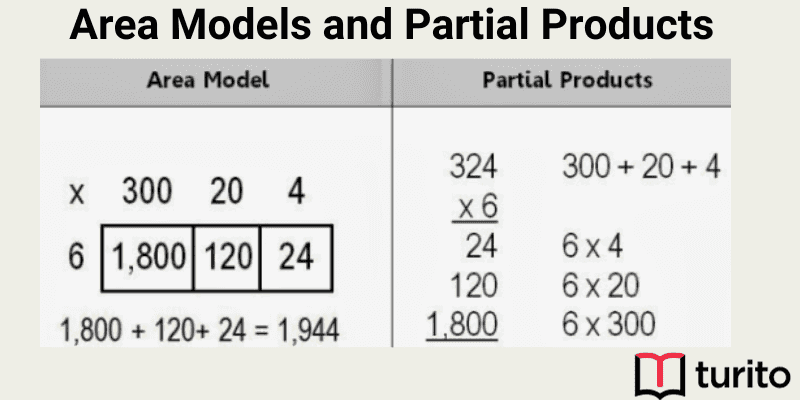Key Concepts
- Applying distributive property in area model
4. 5 Area models and partial products
What is an area model?
Break one large area into several pieces; find the areas of the pieces individually; then add to get the area of the whole.
The below image is an example of an area model.

Partial products:
The partial product method involves multiplying each digit of a number in turn with each digit of another where each digit maintains its place.
Example:
43 x 64 would become (60 x 40) +(60 x 3) +(4 x 40) +(4 x 3)

4. 5.1 Applying distributive property in area model
Kivi walked 23 minutes each day for 15 days. How many minutes did kiwi walk?

Use an area model and the distributive property to find 23 x 15.
Solution:
One way:
Step1: Break apart 23 into 20 + 3

Step2: Multiply 15 x (20+3)
Step3: (15 x 20) + (15 x 3)

15 x 20 = 300, 15 x 3 = 45
Step4: Add the partial products.

Another way:
Use an area model and the distributive property to find 23 x 15.
Solution:
Step1: Write 23 x 15
Step2: Break apart 15 into 10+5.

Step3: Multiply (10 + 5) x 23
Step4: Multiply (10 x 23) + (5 x 23)

Step5: Add the partial products.

Another way:
Multiply 23 x 15
Use an area model and the distributive property to find 23 x 15.
Solution:
Step1: Break apart both factors.
Step2: Break apart 23 into 20 + 3

Step3: Break apart 15 into 10 + 5.

Step4:

Multiply 10 x 20 = 200
Multiply 5 x 20 = 100
Multiply 10 x 3 = 30
Multiply 5 x 3=15
Step5:
Add the partial products.

James walked 345 minutes in 15 days.
Example2:
Dan has a fruit punch shop. During a football game, 24 cups of fruit punch were sold; each cup holds 18 fluid ounces. How many fluid ounces of fruit punch was sold in dan’s shop?

Use an area model and the distributive property to find 24 x 18.
Solution:
One way:
Step1: Break a part 18 into 10 + 8
Step2: Multiply 24 x (10 + 8)
Step3: Multiply (24 x 10) +(24 x 8)

24 x 8 = 192
Step4: Add the partial products.

Another way:
Use an area model and the distributive property to find 24 x 18.
Solution:
Step1: Break apart 24 into 20 + 4.

Step2: Multiply (20 + 4) x 18
Step3: Multiply (20 x 18) + (4 x 18)

Step4: Add the partial products.

Another way:
Step1: Break apart both factors.
Step2: Break apart 24 into 20 + 4.
Step3: Break apart 18 into 10 + 8.

Step4: Multiply 20 x 10 = 200
Step5: Multiply 20 x 8 = 160
Step6: Multiply 4 x 10 = 40
Step7: Multiply 4 x 8 = 32

Step8: Add the partial products.

Exercise:
- Find the product of 35 x 28. Use area model and the distributive property.
- Find the product of 55 x 20. Use area model and the distributive property.
- Find the product of 23 x 36. Use distributive property.

4. Find the product of 15 x 17.

5. Find the product of 30 x 85. Use distributive property.

6. Fill in the blanks in the given image.

7. Find the product of 17 x 26.

8. Draw an area model to find each product.
47 x 56
67 x 42
33 x 12
9. Danial works in the office 18 hours per week. How many hours will don work in 34 weeks?
10. There are 50 toy cars in one shop. How many toy cars are there in 35 shops?
Concept map:

What have we learned:
- Understand an area model and distributive property.
- Understand how to use area model and distributive property to find product for given numbers.
- Understand how to break apart and multiply.
- Identify partial products.
- Understand how to add partial products.

Related topics
Addition and Multiplication Using Counters & Bar-Diagrams
Introduction: We can find the solution to the word problem by solving it. Here, in this topic, we can use 3 methods to find the solution. 1. Add using counters 2. Use factors to get the product 3. Write equations to find the unknown. Addition Equation: 8+8+8 =? Multiplication equation: 3×8=? Example 1: Andrew has […]
Read More >>Dilation: Definitions, Characteristics, and Similarities
Understanding Dilation A dilation is a transformation that produces an image that is of the same shape and different sizes. Dilation that creates a larger image is called enlargement. Describing Dilation Dilation of Scale Factor 2 The following figure undergoes a dilation with a scale factor of 2 giving an image A’ (2, 4), B’ […]
Read More >>How to Write and Interpret Numerical Expressions?
Write numerical expressions What is the Meaning of Numerical Expression? A numerical expression is a combination of numbers and integers using basic operations such as addition, subtraction, multiplication, or division. The word PEMDAS stands for: P → Parentheses E → Exponents M → Multiplication D → Division A → Addition S → Subtraction Some examples […]
Read More >>System of Linear Inequalities and Equations
Introduction: Systems of Linear Inequalities: A system of linear inequalities is a set of two or more linear inequalities in the same variables. The following example illustrates this, y < x + 2…………..Inequality 1 y ≥ 2x − 1…………Inequality 2 Solution of a System of Linear Inequalities: A solution of a system of linear inequalities […]
Read More >>Other topics







Comments: